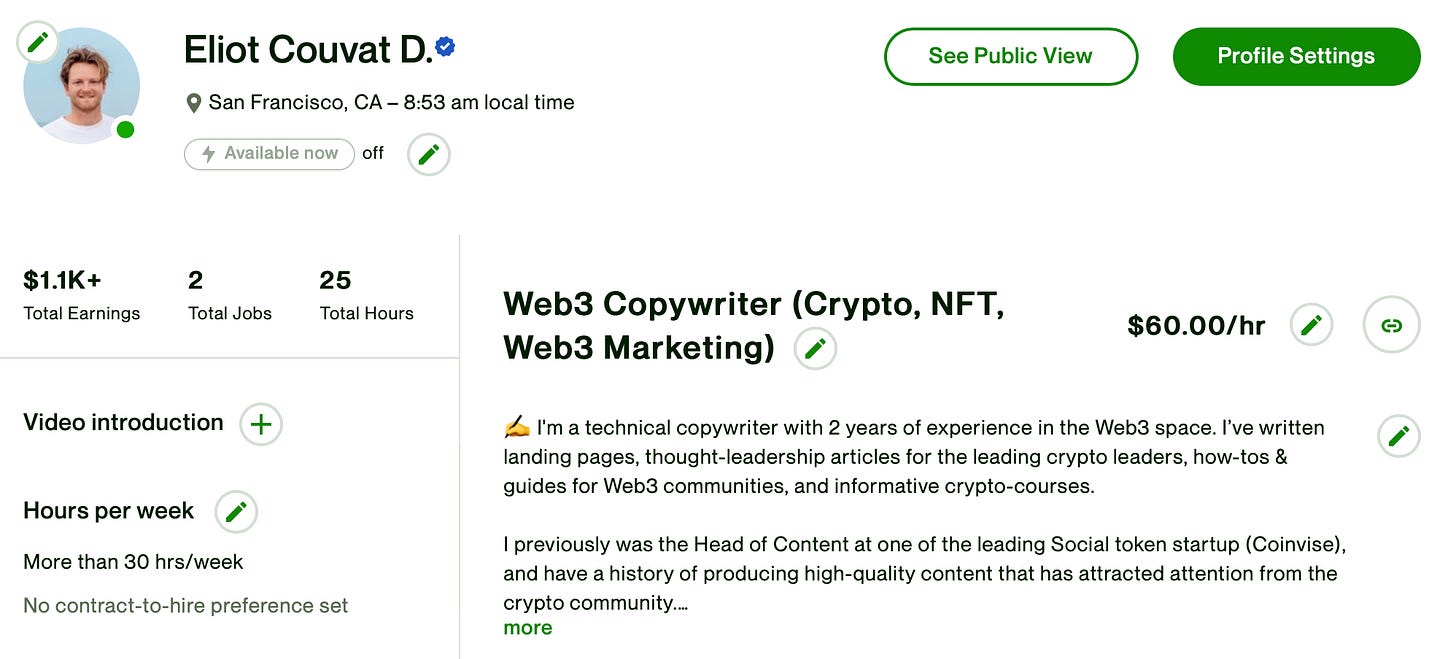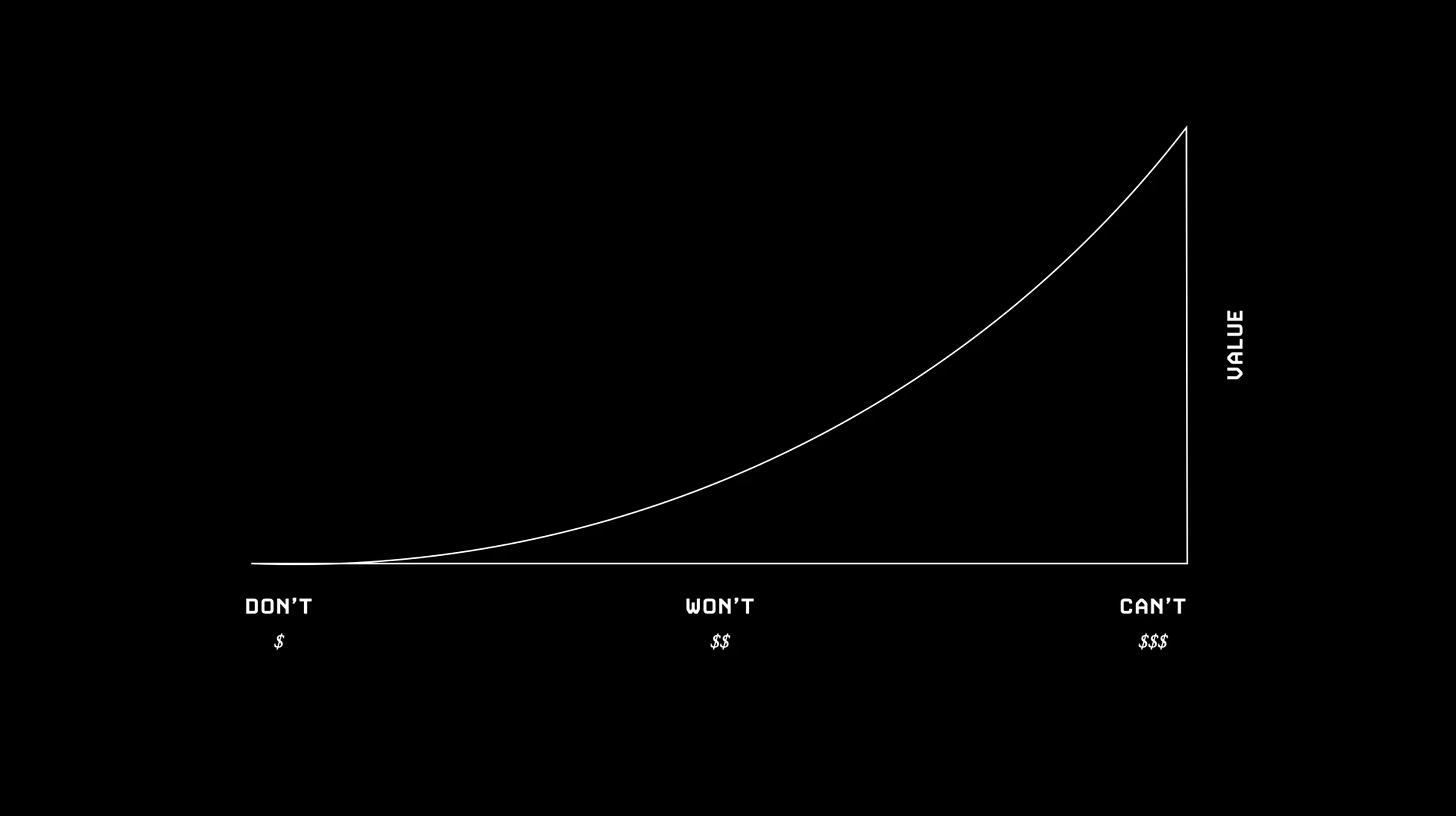Three months ago, I set myself the most ambitious goal of my career:
Becoming a full-time creator and making a living from my ideas.
This is not the first time I set myself an ambitious goal. Two years ago, I left my friends, my job, and my ex-girlfriend in France to come to San Francisco with no connections and no money, hoping to land new opportunities for myself.
But while the first three months before I landed a job at a Crypto startup back in 2021 were tough, I (surprisingly) found the past couple of months even harder.
The reason is the path to finding a new job in a foreign country is hard, but at least straightforward and with a decent percentage of chance to succeed.
To become a top 1% creator on the other hand, you not only have to do everything well, but also make sure those things are the good ones to do in the first place.
No one is telling you what to do, and your chance of success is thin.
So after three months of experiments and mistakes, I thought it was a good time for me to start reflecting and writing down the ups and downs of the past months to help me see the future more clearly, and helping some of you learn from my mistakes along the way.
Without further ado, let's get to it! 😉
1 | Making Money Online
The one thing I was sure about when embarking on this journey was that, to succeed, I needed to set an ambitious (yet reachable) goal with a clear deadline.
So at the beginning of 2023, I set myself a goal:
Make $10,000+ online before January 1st, 2024.


The first question I logically asked myself was: Where do I start?
As a writer, I could follow different business models to achieve this goal.
So I sat down and took the time to explore my options:
Option 1: Selling Products (Books)
This is an option I never really considered. I actually released my first physical book called “The Social Token Revolution” in 2021 and have made ~$1700 since then with royalties. While it’s definitely a decent amount, I doubt I’ll ever make $10K with this book, and considering the amount of work it’d take to write a second one, I doubted it was the best use of time.
Side note: I still released a new eBook called “The 5 Pillars Of Web3 Community Building” a few months back, putting together the playbook I wish I had when I first started building online communities, but since the eBook is free and I only made ~$30 thanks to donations, I dont’t consider it a source of revenue.
Option 2: Selling Services (Ghostwriting)
This is what I did a little bit in January and February through Upwork and some other freelancer platforms. In 2 months, I made roughly $1,400. I know this is where the most money can get made, but honestly, I didn’t really like it.
While writing a couple of articles about how a certain token will go to the moon in the next weeks was fun, I don’t see myself doing this for the next nine months.
If you want to read more about my experience as a copywriter, I shared my thoughts in a recent article.
Option 3: Selling Insight (Consulting)
This is something I’d love to do, and I’ve done it successfully many times while at Coinvise with different Web3 communities, but I didn’t get any leads so far.
(If you’re trying to build a community and could need a little help, my DMs are open! 😉)
Option 4: Selling Digital Access (Paywalled Content)
This is not a path I think would be viable for me at this point since I still have a relatively small audience.
Option 5: Selling Education (Courses)
That was the one. This was something I was very interested in trying and figured was the best format to share my learnings with the maximum amount of people.
So In January, I started working on an online course: The Modern World Builder.
2 | Getting Paid To Teach Something People Can’t Do
To become a top 1% creator, and actually make a living online, I knew I needed to create more value than 99%.
I had three options there:
→ Do things people don't do. (non-specific, low value, $)
→ Do things people won't do. (specific, average value,$$ )
→ Do things people can′t do.(ultra−specific, high value, $$$)
From the beginning, it was very clear that whatever I did, I’d be paid in direct proportion to the difficulty of the problem I solved.
I actually learned the hard way doing ghostwriting for startups.
The difficulty of writing about the growth of a token is fairly low, and it’s something anyone could potentially do with more or less success.
They just didn’t want to do it themselves.
Low problem. Low Value. Low reward.
So when I started working on The Modern World Builder, I focused on teaching something extremely specific, something very few people could do by themselves but that they absolutely needed for their business.
Hard problem. High Value. High Reward.
The question was: What is this hard problem people have that I can solve?
And it didn’t take me long to find one.
In 2022, ~90% of the communities created during the crypto craze disappeared.
In fact, as of February 2023, we were counting only 47 key Web3 communities.
This meant only 10% of Web3 community leaders had succeeded in making their community reach its cultural moment, that moment that cements a community into a state of enduring relevance.
There was a *real* difficult problem I could tackle.
After spending 2 years at Coinvise, I knew I was skilled in community building, and I decided to focus on that.
3 | The Modern World Builder
The second question from there was: How do I make something different?
How can I take a different approach and bring my vision of community building?
Because, let’s face it, there are already a ton of courses about community building, and coming up with the same pieces of advice wouldn’t make me succeed.
So what was that differentiator I could bring to the table?
If you are a community builder or have been looking at some online community courses, you may have noticed many of them (if not all) are focusing on growth, promising to help you gather the maximum number of people in your Discord.
But I don’t believe growth = success.
A community-building thesis that optimizes for accelerated growth necessarily leads to a dilution of intimacy, and without intimacy, no community can stand the test of time.
So instead of creating yet-another course teaching how to build communities with a focus on large-scale target audiences, I decided to take the opposite approach and teach how to move to smaller-scale audiences turned into communities by shared passions and goals.
I focused on creating a course teaching community builders how to reach their cultural moment, and how to build a culture of intimacy through shared symbol systems instead of growth at all costs.
4 | Asking for feedback
I knew, of course, that creating such a course would take months of deep research.
So instead of spending hundreds of hours creating this course, I launched a light version with only a couple of modules to validate the interest.
And in a matter of hours, I sold the first 25 copies at $1.
So I gathered early feedback, improved the course, increased the price, and sold out again the next 25 copies at $15 in a matter of days.
This time, I took more than a few days to revamp the course and drastically improve the content. I added new lessons, added more concrete examples, and invested in a community tool.
After a few weeks, I raised the prices to $59 and sold a couple of copies again.
The lesson here:
At each step of the process, with each new customer, gather feedback.
Ask your first customers which modules to delete, which ones to add, and which ones you should double down on.
Over the weeks, you’ll get a much clearer vision of how you can provide value.
So following this strategy, I kept asking for feedback on Twitter and shared my learnings in public, improving the course in real-time.
And today, after three months of grind, here are the statistics of the course:
$770 in revenue is definitely not life-changing money, but it validated an interest and, above all, kept me motivated and confident about what I was doing.
Following this multi-releases strategy also helped me gather some awesome first reviews for the course:
And after almost 90 days of building this course, I am sharing here with you everything I have learned since the beginning of this journey.
| Closing Thoughts
Creating a $10,000 educational online product is far from an easy journey.
And three months in, I'm clearly not there yet.
Actually, reflecting on those first 3 months, I have more questions than answers:
Should I turn that into a cohort-based course?
How much should I charge for the course? $1500 like the other courses??
How do I better show the value of this course?
Should I open it up and go beyond Web3 communities?
All those questions will surely keep me busy for the new few months.
But at least in 90 days, I've validated an early interest and created the early elements of the product of my dream.
And the question from there is:
How do I go from a pilot with 70 customers to my first 1000 customers?
This is just the first chapter of a long journey for me.
I hope those thoughts have helped you.
I'll come back next week with more actionable tips on how to build communities.
And if you're a community builder interested in learning more about The Modern World Builder, you can check it out here!
Speak soon,
- Eliot
As someone who went through the ups & downs of content creation and Web3 community building, I can assist you in two ways:
The 5 Pillars of Web3 Community Building: If you need help starting & growing your community, I’ve written a free 40-pages guide with all the best practices I've discovered to launch, grow and monetize your Web3 community. Grab a copy here:
The Modern World Builder - A Handbook to Collective Symbol System: If you’ve already created a community and are now looking to unlock the next phase of your journey, I’ve created a written course that’ll show you how to arouse a feeling of belonging and expand your community’s culture.








